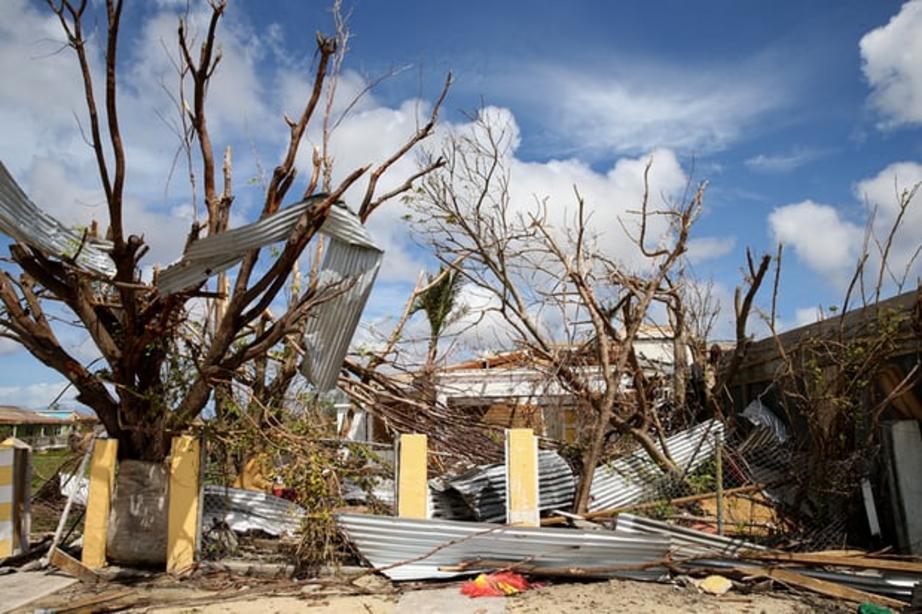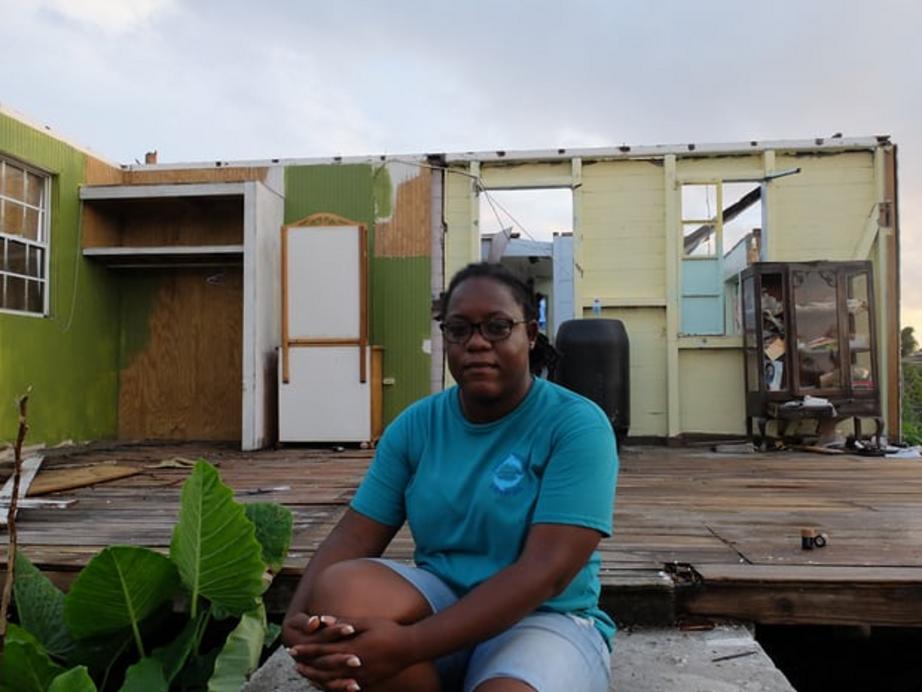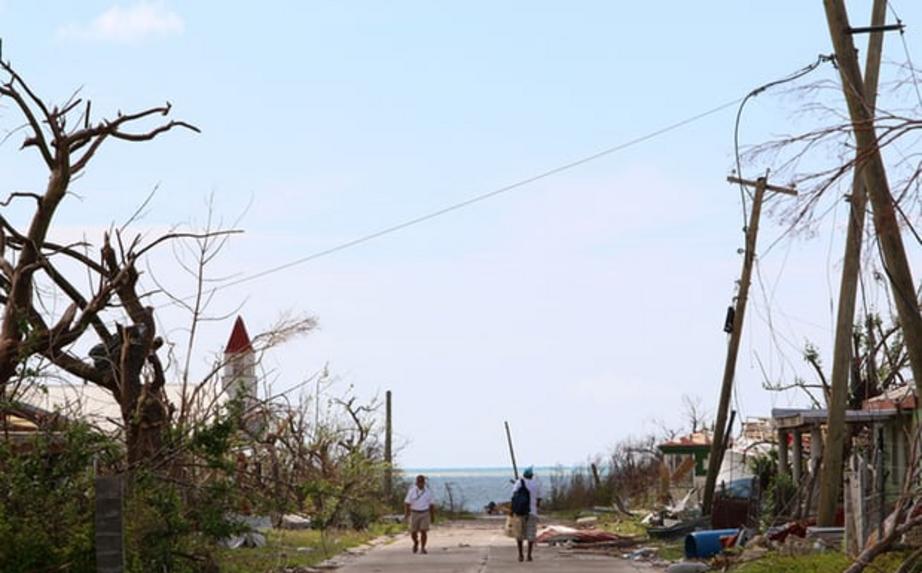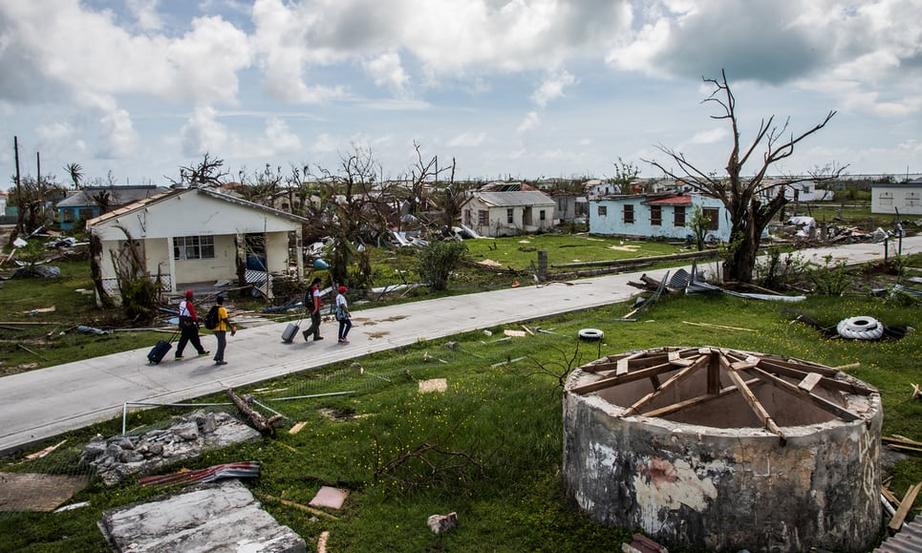The night Barbuda died: how hurricane Irma created a Caribbean ghost town
Walking the streets of the small Caribbean island of Barbuda on a Friday afternoon, you are likely to see more goats than humans.
Dogs, cats and horses, all of which roam freely about the island now that fences are down, also seem to outnumber people. The streets are empty and the houses – at least the ones still standing – are abandoned. The island is like a ghost town.
Barbuda, which covers only 62 square miles, was the first to feel the force of Hurricane Irma. When the storm made landfall on the night of 6 September, it hit Barbuda at about 185mph. A two-year-old boy died and an estimated 90% of properties were damaged.
Two days later, fearing Barbuda would be hit again, this time by Hurricane Jose, the prime minister ordered an evacuation. All 1,800 residents were ferried to Antigua, Barbuda’s much larger sister island, which suffered only minor damage.
Jose passed without incident, but the government warned that diseases caused by stagnant water and issues with vermin had rendered it unsafe for habitation, and it was three weeks before residents were allowed to return. Even now, weeks after the evacuation order was lifted, this island is eerily deserted.
 Debris in the Codrington lagoon, Barbuda.
Debris in the Codrington lagoon, Barbuda.
“Barbuda is quiet, quiet, quiet. It’s dead,” says Kendra Beazer, 24, the youngest member of the Barbuda council, the island’s ruling body.
Another councillor, Wayde Burton, 38, says that Fridays - when I visited the island - through to Sundays were the quietest times for the island as people come over from Antigua early in the week and stay a few days to clean up before going back to Antigua for the weekend.
Burton says life is slowly returning to the island, although little more than a tenth of its population has returned. Two months after the hurricane hit, a restaurant, a bakery and a supermarket have opened their doors, though, as electricity is yet to be restored, the businesses are running off generators. But even at its most occupied, Burton estimates there are 250 people on the island.
Beazer and Burton travel back and forth between the islands. In Antigua, Beazer stays in a rundown hotel, paid for by the government. Some Barbudans are staying with friends and family in Antigua or abroad, others in impromptu shelters.
One shelter, at the Sir Vivian Richards cricket stadium, is run by stadium staff and overseen by Denise Harris, the arena’s HR and accounts manager. She recalls how her boss was called by a government minister on the day of the evacuation. “They said: ‘We are sending you 80 Barbudans.’ We had 197. We thought it was just for two weeks or so, but now it’s two months. They were just brought here, nothing was in place for them.”
Harris says the stadium has remained largely functional despite the continued presence of 142 people, but is adamant the situation cannot continue. “Honestly, I don’t think they can be here past the end of December,” says Harris. “We have England coming in February.”
She says the large number of supporters accompanying the England team can sometimes be a handful, with weeks of preparation necessary. That would be impossible with the locker rooms full of people on camp beds.
Some aid agencies are operating on Barbuda. Samaritan’s Purse, housed in a large white tent, is among those on the island, and has been providing equipment and water treatment units. The Red Cross has brought medical kit, enabling the consulting and emergency rooms at the Thomas Hanna hospital to reopen.
Yet the rebuilding efforts seem piecemeal. Burton cleans and repairs houses with a group of friends. They scrounge plywood and corrugated iron from the wreckage to patch up roofs.
On Dominica, a nearby island devastated by Hurricane Maria, aid organisations are out in force and each night the military clears debris from the streets. Barbuda feels almost abandoned in comparison.
The recovery effort has been challenging. Few people on the island have house insurance, while many rent their homes; neither group is clear about its role in the rebuilding process. But Barbudans agree the evacuation has made rebuilding far slower.
 Knacynthar Nedd, leader of the Barbuda council, sits on the doorstep of a house that lost two walls and its roof.
Knacynthar Nedd, leader of the Barbuda council, sits on the doorstep of a house that lost two walls and its roof.
“Lots of homeowners refuse to come back home because they say there’s nothing for me to come back to,” says council leader Knacyntar Nedd as she cleans out a building. “We had to leave the next day [after the hurricane], so people didn’t have time to process the damage to their homes. Now people are seeing the magnitude of the damage. They get here, they walk around their house, they pick up a few things – and then they go back to the boat.”
In some cases, property damage that was initially minor has been compounded by the prolonged absence from the island. Beazer’s house, which has a concrete roof, survived the storm in reasonable shape. But the shutters were blown off and the windows broke. The evacuation order meant he had to leave the island before he could repair the windows, and rain got into his property, ruining most of his belongings.
“We had to stay in Antigua, and so much of the stuff started to grow mould and smell, so I just had to throw everything away,” he says.
Burton and Beazer are both members of the Barbudan People’s Movement, which sits in opposition on the Barbuda council and in the federal legislature. They blame the government for the slow recovery. They think Gaston Browne’s Antigua Labour party government is using the hurricane to consolidate power in Barbuda, particularly over land, which is held through a complicated tenure system.
A few days after the hurricane, the prime minister proposed revising the system to allow Barbudans to buy their title deeds for $1. Beazer, who finds the announcement’s timing suspicious, calls the policy “disaster capitalism”.
He and Burton are also angry that work on building a large commercial airport on Barbuda, part of the deal for the Paradise Found resort funded by Robert De Niro and James Packer, resumed quickly after the hurricane, well before the small airport was refenced and made operational again.
“When you hear that they’re already clearing land to build the new airport, yet you haven’t put up the fence at the old airport to allow for regular travel, it makes you question,” says Beazer.
 Devon Warner and his daughter Che Niesha work on the roof of a home in Codrington, Barbuda.
Devon Warner and his daughter Che Niesha work on the roof of a home in Codrington, Barbuda.
Interviewed in his office in Antigua, Browne acknowledges rebuilding had been slow. “It’s been about six weeks and we’ve not made significant progress,” says the prime minister. “We just don’t have the resources.”
He says this is because the government wants to build more climate-resilient homes, which requires financial resources Antigua and Barbuda doesn’t have. “If we do not raise the necessary resources we’ll be forced to do patchwork, to rebuild existing properties with the same galvanised roofs and so on, and next hurricane we’ll be back to square one.”
Eli Fuller, an Antiguan businessman who runs a boat tour company, says some of the blame for the delays has to be shouldered by Barbudans themselves. “They’re not going over to clean their own homes,” says Fuller. “It’s their culture from birth that everything is done for them. I don’t know how Antigua is going to get them out of the shelters.”
Fuller has made more than 40 trips and counting to Barbuda since the hurricane, transporting people and supplies. He is scornful of Antiguans he knows who, he says, sent money and aid to Dominica after Hurricane Maria, but didn’t send anything to Barbuda out of resentment.
This reflects the mistrust between the two islands. Barbudans say Antiguans look down on them and want to control their island; Antiguans say Barbudans sponge off their tax dollars and use the complicated land system to deny access to Antiguans wanting to start businesses there.
 Barbuda’s Codrington lagoon after Hurricane Irma. The storm inflicted catastrophic damage.
Barbuda’s Codrington lagoon after Hurricane Irma. The storm inflicted catastrophic damage.
“Honestly, we were never close,” says Harris, the woman running the shelter at the cricket stadium. “We say we are brothers and sisters, but we’re not. I used to think, the further away the better. I think the hurricane was needed to bring us closer. I’ve never been so close to so many Barbudans.”
No one knows if or when Barbuda will return to normal. Estimates range from one to three years.
Fuller has the bleakest prognosis. “The Barbuda as we know it died with that evacuation order,” he says. “They don’t want to go back. How can they go back? Why would they go back?”
On that issue, all are agreed: if Barbuda is to have a chance of recovery, it needs to be reinhabited. “The more we stay away the more we’re going to lose,” says Burton.

